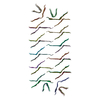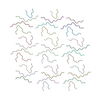+Search query
-Structure paper
| Title | Engineering of antimicrobial peptide fibrils with feedback degradation of bacterial-secreted enzymes. |
|---|---|
| Journal, issue, pages | Chem Sci, Vol. 14, Issue 39, Page 10914-10924, Year 2023 |
| Publish date | Oct 11, 2023 |
 Authors Authors | Fenghua Wang / Wencheng Xia / Mingming Zhang / Rongrong Wu / Xiaolu Song / Yun Hao / Yonghai Feng / Liwei Zhang / Dan Li / Wenyan Kang / Cong Liu / Lei Liu /  |
| PubMed Abstract | Proteins and peptides can assemble into functional amyloid fibrils with distinct architectures. These amyloid fibrils can fulfil various biological functions in living organisms, and then be degraded. ...Proteins and peptides can assemble into functional amyloid fibrils with distinct architectures. These amyloid fibrils can fulfil various biological functions in living organisms, and then be degraded. By incorporating an amyloidogenic segment and enzyme-cleavage segment together, we designed a peptide (enzyme-cleavage amyloid peptides (EAP))-based functional fibril which could be degraded specifically by gelatinase. To gain molecular insights into the assembly and degradation of EAP fibrils, we determined the atomic structure of the EAP fibril using cryo-electron microscopy. The amyloidogenic segment of EAP adopted a β-strand conformation and mediated EAP-fibril formation mainly steric zipper-like interactions. The enzyme-cleavage segment was partially involved in self-assembly, but also exhibited high flexibility in the fibril structure, with accessibility to gelatinase binding and degradation. Moreover, we applied the EAP fibril as a tunable scaffold for developing degradable self-assembled antimicrobial fibrils (SANs) by integrating melittin and EAP together. SANs exhibited superior activity for killing bacteria, and significantly improved the stability and biocompatibility of melittin. SANs were eliminated automatically by the gelatinase secreted from targeted bacteria. Our work provides a new strategy for rational design of functional fibrils with a feedback regulatory loop for optimizing the biocompatibility and biosafety of designed fibrils. Our work may aid further developments of "smart" peptide-based biomaterials for biomedical applications. |
 External links External links |  Chem Sci / Chem Sci /  PubMed:37829030 / PubMed:37829030 /  PubMed Central PubMed Central |
| Methods | EM (helical sym.) |
| Resolution | 2.35 - 2.62 Å |
| Structure data | EMDB-34392, PDB-8gz8: EMDB-34393, PDB-8gz9: |
| Chemicals |  ChemComp-HOH: |
| Source |
|
 Keywords Keywords | ANTIMICROBIAL PROTEIN / antimicrobial fibrils / amyloid |
 Movie
Movie Controller
Controller Structure viewers
Structure viewers About Yorodumi Papers
About Yorodumi Papers







 homo sapiens (human)
homo sapiens (human)